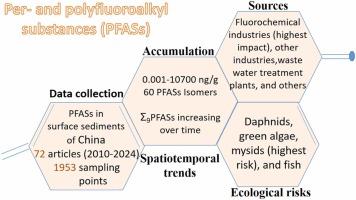Characterization of per- and polyfluoroalkyl substances (PFASs) in Chinese river and lake sediments
IF 12.2
1区 环境科学与生态学
Q1 ENGINEERING, ENVIRONMENTAL
引用次数: 0
Abstract
Sediment pollution by per- and polyfluoroalkyl substances (PFASs) is an emerging environmental concern with far-reaching implications, attracting considerable public, scientific and regulatory attention. This study analyzed 72 articles published since 2010 to assess the accumulation, sources, spatiotemporal trends, and contributing factors of PFAS pollution in surface sediments across China. The total concentrations of PFASs at the reviewed sites ranged from 0.001 to 10700 ng/g, with the maximum concentration detected in the Xiaoqing River, Shandong province. Excluding the Xiaoqing River, the mean total PFAS concentrations at other sites were below 200 ng/g. Although long-chain PFASs have been frequently associated with sediment phases due to their hydrophobicity, short-chain legacy and emerging PFASs also exhibited high concentrations, often being the dominant analytes at several sites because of their significant partition coefficients in sediments of China. Fluorochemical industries were identified as the most significant contributors to sediment PFAS accumulation, with concentrations up to ten times higher than those in areas affected by other sources. Risk assessments revealed differing outcomes based on chronic and acute toxicological data. Acute data indicated high ecological risks to aquatic organisms—including daphnids, green algae, mysids, and fish—from long-chain PFCAs and PFOS exposure at up to 19 sites. In contrast, chronic data derived from SSD for PFOS and PFOA, considering the maximum concentrations found across sites, suggested high chronic risks at only 1 and 4 sites, respectively. These findings, combined with the widespread occurrence of fluorochemical industries and the adsorption and bioaccumulative behavior of legacy and emerging PFASs in sediments, underscore the need for expanded assessments in underrepresented regions of China to comprehensively evaluate ecological and human health risks.

求助全文
约1分钟内获得全文
求助全文
来源期刊

Journal of Hazardous Materials
工程技术-工程:环境
CiteScore
25.40
自引率
5.90%
发文量
3059
审稿时长
58 days
期刊介绍:
The Journal of Hazardous Materials serves as a global platform for promoting cutting-edge research in the field of Environmental Science and Engineering. Our publication features a wide range of articles, including full-length research papers, review articles, and perspectives, with the aim of enhancing our understanding of the dangers and risks associated with various materials concerning public health and the environment. It is important to note that the term "environmental contaminants" refers specifically to substances that pose hazardous effects through contamination, while excluding those that do not have such impacts on the environment or human health. Moreover, we emphasize the distinction between wastes and hazardous materials in order to provide further clarity on the scope of the journal. We have a keen interest in exploring specific compounds and microbial agents that have adverse effects on the environment.
 求助内容:
求助内容: 应助结果提醒方式:
应助结果提醒方式:


